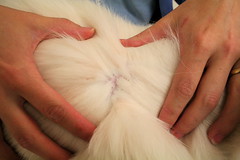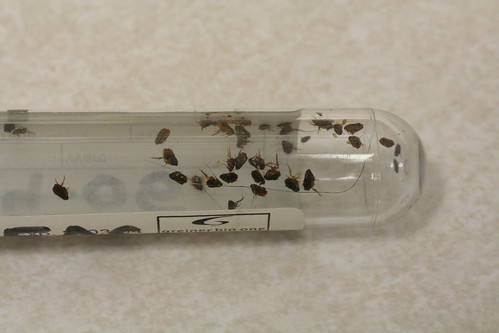We are finally reaching the end of what has been a horrible allergy season, and the environmental conditions that make allergies so bad are great for fleas. We’ve been seeing lots and lots of flea cases over the past number of months (yes, even into December!), and we expect to see more as December unfolds. If a flea made it into your home during the warmer months, it doesn’t matter how cold it gets outside, that flea is loving your home environment. This is why we see flea cases year-round. What can be done to stop this?
Here to talk about fleas and flea control is a colleague of ours, Angee Dyer, DVM, from Shadowridge Veterinary Hospital in Vista, CA. Dr. Dyer hit a homerun with her commentary on fleas, and we want to share it with you. Sprinkled in her text will be some additions to personalize it to the Cuyahoga Falls Veterinary Clinic. Take it away, Dr. Dyer…
The Flea, a tiny but challenging enemy
Fleas spend all of their adult lives on a dog or cat. They will never leave that animal unless forced to do so, or when that animal dies. Why should they? They have access to food (blood) and mates! Within 5 minutes of jumping onto a pet, the flea will take a blood meal and pass stool (poop). Flea poop is visible on pets’ fur as flea “dirt,” little black specks that look like pepper, that turn red or brown when exposed to water. The fleas will then mate and the females will lay their eggs on the pet. The flea eggs are little white specks that look like salt. It takes a female flea less than 24 hours to lay eggs once she is on a pet.
|
The flea eggs and flea poop fall off the pets where the pets sleep or where they jump on and off furniture or go up and down stairs. The flea eggs will hatch into little larvae. These larvae are very small and look like little maggots. These maggots will burrow down into carpets, bedding, or cracks/crevices in wood or tile. The maggots eat the flea poop that also fell off the pet. After a while, those maggots will spin a cocoon. While in the cocoon, they are known as pupae.
Pupae are extremely resistant to being killed in that cocoon, and they can lie dormant for up to 9 months! Pupae are stimulated to emerge from their cocoons by heat and vibration (an animal walking by or a vacuum for example). A baby flea will emerge from the cocoon, and will jump on the next warm body that happens by. If all goes according to plan, it is a dog or cat. If it is a person, that person will get bitten.
If a person is being bitten by fleas, it is a commentary on the intense flea burden in the environment. Biting the people are baby fleas in the environment (house) newly emerging from cocoons, not fleas jumping off a pet! You already have an infestation.
If flea dirt (poop) is found on a pet, the fleas have been present on the pet for more than 24 hours and have already laid eggs. Undoubtedly some of those eggs have fallen off of the pet and the infestation is underway.
|
The only way to effectively control fleas in our area is to treat all pets all year round and break the flea life cycle. Do not only treat your pet when you see a flea – you are already too late! Prevention is the key!
As an aside, fleas can spread tapeworm to pets. Tapeworms can be spread to people and can be especially problematic for children.
Flea control and prevention protocol:
The following recommendations are intended to prevent or eliminate fleas without the need to spray insecticides around your house and yard. This simple protocol will minimize your family’s and pet’s exposure to insecticides.
1. Apply a good, safe, effective flea adulticide. At the Cuyahoga Falls Veterinary Clinic, we are most impressed with Parastar Plus®, as it has the most rapid kill of the longer-term, topical treatments. Trifexis®, and Revolution® are also safe, effective products that we recommend and carry for our patients. Use one of these products every month, year round, without break.
(Revolution® and Trifexis® also incorporate heartworm preventive, so if you are using either of these on a monthly basis for heartworm preventive, you’re already being proactive with flea control.)
|
2. If you see fleas, apply Parastar Plus®, Frontline®, or Advantage® for at least 9 months in a row (preferably year-round). Parastar Plus®, Frontline®, and Advantage® are much safer and more effective than many cheaper and older insecticides, such as those made by Hartz. The safe products work by floating in the oil layer on the pet’s skin. These products should not be applied until 48 hours after bathing, and the pet should not be bathed again for at least 2 days as they need the natural oils on the pet to work. These are best applied in the evening, when the pet won’t need to be handled for some time after application. To be hygenic and cover all of the safety bases, wash your hands after applying.
If you do not use any of the products mentioned above on a consistent, monthly basis, you are at risk for an infestation and recurring flea problems. The doctors here at Cuyahoga Falls Veterinary Clinic see many cases of flea-caused skin disease even in the winter!
3. Treat the environment! The live fleas you see on your dog or cat only account for 10% of the total fleas in the pets’ environment. They are the tip of the iceberg. The rest of them are eggs, larvae, or pupae and they’re in the carpets, blankets, bedding, upholstered furniture, doormats, etc. You must tackle these as well if you have an infestation. First, remove as many eggs, larvae, and pupae from the environment as possible.
Wash all bedding in the washer and dryer. Be sure to wash all pet beds, blankets, and all human bedding (if pets sleep on people’s beds) in the washer and dryer.
Vacuum all carpets thoroughly. Empty the vacuum canister or bag out outside of the house, then immediately vacuum again. Again, empty the vacuum out outside of the house. Vacuums emit heat and cause vibration, so they can stimulate fleas to emerge from cocoons.
Pick up Borax powder from a home improvement or pet store and spread it liberally on floors or furniture. Work the powder into the carpet or floorboards with a stiff bristled broom. Borax is nontoxic to people and pets, but will kill flea eggs and larvae by drying them out. It does not kill the pupae in the cocoons.
(For the particularly infested environments, we keep Mycodex House Spray in stock for treating carpets, blankets, bedding, etc. While it is an insecticide, this is nice because you can target the use of the product, and there is no wasted product. Using Mycodex will help debulk the immature flea burden in the environment and minimize the adults that will be seen in the coming months.)
4. Hang in there! Because the fleas are in various stages of their life-cycle, it may take a few months to gain control of the situation once and infestation has set in. Remember, the pupae in their cocoons are extremely resistant to environmental treatment. We have to either remove all the tiny cocoons, or wait until the fleas emerge and jump on the pet. This is why the pet must be continually treated with one of the recommended products above. We don’t want the cycle to start all over again.
Right after you start, there may be a large hatch, because all those fleas in the cocoons emerge at once. Don’t worry, the products work! They just have to catch up to all those newly hatched fleas. If you are seeing live fleas on your pet despite having used one of the recommended products within the last 30 days, please give your pet a Capstar® pill. This will not harm the pet or interact with the other products. It will kill those fleas on that pet. You can give Capstar® as often as 3 times a week if you need to do so. Capstar® is the most rapid-kill product and can provide your pet relief from the flea bites while the treatment plan above is allowed to work over the long-run.
——————–
Dr. Dyer is right on the money with her suggestions. One last thing I want to re-enforce:
It. Takes. Time.
If your expectations are set appropriately, you’ll be pleased with the progress and results. A flea infestation is winnable battle. Don’t be stressed, don’t be frustrated. We can win the battle together!
Questions? Call us at 330-929-3223





Joy McGowan
I am running in to this problem with fleas. I have a white toy poodle and a white bicheon. Both have frontline or advantix 2. Every night I full fleas off my poodle and I do thr same every morning. I seem not to catch up. I keep steam cleaning our tile floors everyday and one room of carpet. I have bath the poodle twice eith flea shampoo and still I have the problem. Our vet is giving me a pilk to give to the dogs that will kill the adult flea within 2 hours but it does not kill the eggs or larve. I can’t give them the pill until sunday coming up because I have already put thr flea treatment on them. I have to wait 2 weeks. In between I am going through this washing and vacuuming and steam cleaning everyday. It was very helpful to know that the eggs drop off and land anywhere so easily. I will try you carpet solutions. Can you offer any additional advice? Can I spray or powder my matress?
Thank you,
Joy McGowan.
Dr. Ryan Gates
Joy, it sounds like you’re doing everything right. The oral flea control treatments provide a quicker kill, providing less flea-chewing on your dogs. What you’re dealing most with is the environmental bloom. The flea gurus, the parasitology professors and clinicians at the veterinary colleges talk about regular use of a flea kill treatment (which you’re doing), and regular vacuuming. As in, daily vacuuming. Stay the course. I’ve not yet had a client have to move because we were unsuccessful in dealing with fleas.